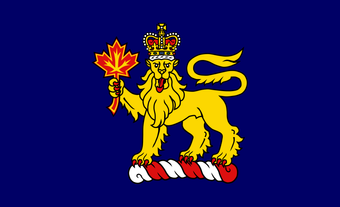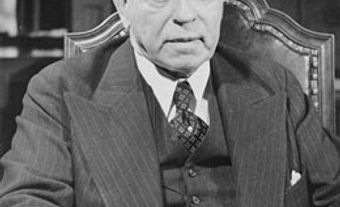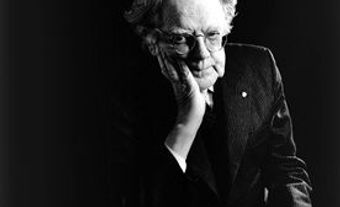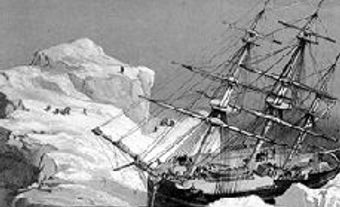John Buchan, 1st Baron Tweedsmuir, governor general of Canada from 1935 to 1940, novelist and historian (born 26 August 1875 in Perth, Scotland, United Kingdom; died 11 February 1940 in Montreal, Quebec). Tweedsmuir was a prolific author; his most famous novel, The Thirty-Nine Steps (1915), was adapted into a 1935 film directed by Alfred Hitchcock. He also created the Governor General’s Literary Awards in Canada.

Early Life and Education
John Buchan was the eldest of five surviving children of John Buchan, a Free Church of Scotland minister, and Helen Jane Masterton, who came from a sheep farming family. He received his secondary education at Hutchesons’ Grammar School in Glasgow and went on to study classics at the University of Glasgow in 1892. In 1895, Buchan received a Junior Hulme scholarship to Brasenose College at the University of Oxford, where he received a master of arts degree. He was called to the Bar at Middle Temple in London in 1901 and specialized in commercial law.
Marriage
On 15 July 1907, John Buchan married Susan Charlotte Grosvenor, a cousin of the Duke of Westminster and the daughter of Captain Honourable Norman de l’Aigle Grosvenor, a Liberal British Member of Parliament from 1869 to 1874, and Caroline Stuart-Wortley, a novelist and founder of the Women’s Farm and Garden Union (now the Working for Gardeners Association). Susan Buchan was a childhood friend of Virginia Woolf and the author of several novels, biographies and children’s books, some of which were published under the name Susan Tweedsmuir after she became viceregal consort of Canada.

Children
John and Susan Buchan had four children. Alice Caroline Fairfax-Lucy (1908–93), their eldest child, became an author and archivist. John Norman Stuart, 2nd Baron Tweedsmuir (1911–44), was a military officer, a naturalist and an explorer who joined the Hudson’s Bay Company, travelled 3,000 miles by dogsled in the Arctic and spent the winter of 1938–39 in Cape Dorset (now known as Kinngait) on Baffin Island. William James de l’Aigle, 3rd Baron Tweedsmuir (1916–2008), was a Royal Air Force pilot and poet, and Alastair Francis (1918–76) served in the Canadian forces during the Second World War.
Journalist, Historian and Politician
John Buchan served as a private secretary to the High Commissioner in South Africa from September 1901 to July 1903 during the Second Boer War, meeting with Commonwealth troops, including Canadians. After returning to the United Kingdom, he worked as an author, a lawyer and a journalist for The Spectator and a literary advisor to publishing company Thomas Nelson. Buchan was rejected for active service during the First World War because of a duodenal ulcer. Instead, he became a war correspondent for The Times and wrote a 24-volume contemporary history of the war. In 1918, Buchan became head of intelligence, reporting to the Minister of Information, the Canadian-born Lord Beaverbrook. In 1927, Buchan was elected as a British Member of Parliament for the Unionist Party, representing the Combined Scottish Universities until his appointment as governor general of Canada in 1935.
Novelist and Biographer
John Buchan was a prolific author throughout his life, writing more than 100 books, including historical novels, biographies and a memoir that was published posthumously. He published his first poem, a New Year’s hymn, in 1887, at the age of 11, and his first novel, Sir Quixote of the Moors, as a student at the University of Oxford. His most famous adventure novel, The Thirty-Nine Steps (1915), has been adapted for radio, theatre, television and, most famously, a 1935 film directed by Alfred Hitchcock. Buchan saw the film and pronounced it, “Better than the book” and “First rate. Much better than my way.”
In 1924, Buchan wrote a biography of Lord Minto, the governor general of Canada from 1898 to 1904. Buchan travelled to Canada for the first time that same year, visiting Ottawa, Toronto, Montreal and Quebec City. In Ottawa, he was hosted by Prime Minister William Lyon Mackenzie King at Laurier House and Governor General Viscount Byng of Vimy and Lady Byng at Rideau Hall.
Buchan continued his literary career during his time as governor general, writing a biography of the Roman emperor Augustus — dedicated “To my friend William Lyon Mackenzie King, four times Prime Minister of Canada” — as well as his own memoir, Memory Hold-the-Door, at Rideau Hall. Buchan’s final novel, Sick Heart River, which was published posthumously in 1941, was inspired by the Nahanni River of the Northwest Territories, which was close to where he travelled on a voyage down the Mackenzie River in 1937. A collection of his speeches as governor general of Canada, entitled Canadian Occasions, was published posthumously in 1941.
Governor General of Canada
Both Mackenzie King and Prime Minister R.B. Bennett favoured John Buchan’s appointment as governor general, admiring his literary accomplishments and what Mackenzie King described as “his delightful quiet English manner.” Buchan was the first governor general of Canada, who did not have a title at the time of his appointment. On 1 June 1935, King George V made Buchan the 1st Baron Tweedsmuir of Elsfield in honour of the Tweed Valley in Scotland, where he grew up, and Elsfield, Oxfordshire, in England, where he had purchased a country manor after the First World War.
Tweedsmuir was the first governor general to be appointed after the 1931 Statute of Westminster granted Canada autonomy concerning foreign policy. He therefore emphasized that he did not represent the British government but the Canadian Crown, stating in a 1938 speech, “Canada is a sovereign nation and cannot take her attitude docilely from Britain or from the United States. A Canadian’s first loyalty is not to the British Commonwealth of Nations but to Canada and to Canada’s King.”
Tweedsmuir travelled extensively in Canada, meeting Canadians from a wide variety of backgrounds. In March 1936, he toured the Eastern Townships of Quebec, stopping in small towns to meet local residents and delivering speeches in French and English. On 1 December 1936, he wrote to his wife, Susan, “At Regina on Saturday afternoon, I visited the community halls of the Germans, Poles, Hungarians, Romanians, Ukrainians, White and Red [see Russian Canadians], and the Jews and spoke in each.” He was invested as Chief Eagle Head of the Kainai Nation (Blood Tribe) in Alberta. A photograph by Yousuf Karsh of Tweedsmuir wearing the war headdress, presented to him by Chief Shot-Both-Sides, was widely circulated in the press and appeared in his memoir.

In 1937, he toured the Maritime Provinces. Tweedsmuir was especially interested in British Columbia and Canada’s Arctic. He made many high-profile visits to the region, following in the footsteps of Alexander Mackenzie by travelling along the Mackenzie River to Aklavik at the river delta and then flying to Great Bear Lake, Kugluktuk and Tuktoyaktuk in 1937.
Tweedsmuir received honorary doctor of laws degrees from the University of Toronto, McGill University and the University of Montreal.

Governor General’s Literary Awards
Tweedsmuir was active in Canadian literary circles as governor general, becoming honorary president of the Canadian Authors Association. At the suggestion of the Canadian Authors Association president, Pelham Edgar, Tweedsmuir created the Governor General’s Literary Awards. The first medals were awarded to Bertram Brooker for Think of the Earth (fiction) and Thomas Beattie Roberton for T.B.R.: Newspaper Pieces (non-fiction), published in 1936. Tweedsmuir also provided encouragement and support for individual Canadian authors, such as Thomas Raddall and Kenneth Millar, and promoted Canadian poetry, delivering a lecture at the University of Toronto in November 1937 intended “to foster an interest in Canadian poetry.”
The Abdication Crisis
When King George V died in 1936, Tweedsmuir led the mourning in Canada. Rideau Hall was covered in black crêpe. When the new heir to the throne, Edward VIII, expressed his intent to marry a twice-divorced American woman, Wallis Simpson, Tweedsmuir advised British Prime Minister Stanley Baldwin concerning Canadian public opinion, stating that while Edward was personally very popular in Canada, Canadians still held “Victorian sensibilities” and would not accept a divorcée as queen. Edward abdicated on 10 December 1936 and his younger brother succeeded to the throne as King George VI.
The 1939 Royal Tour
Tweedsmuir encouraged the new King George VI and Queen Elizabeth (later the Queen Mother) to visit Canada. While Mackenzie King was present at every major stop on the six-week Canadian tour and accompanied the King and Queen to meet U.S. President Franklin D. Roosevelt at Hyde Park on Hudson, Tweedsmuir’s view was that “I should like to keep as much in the background as possible and let it be Canada’s show.” Tweedsmuir officially welcomed the King and Queen in Ottawa and hosted them at Rideau Hall for three days of public engagements. The visit included one of the earliest royal walkabouts, where the King and Queen spoke with a crowd of First World War veterans — an especially significant moment just before the outbreak of the Second World War.

American Relations and the Second World War
In 1936, Tweedsmuir became the first governor general of Canada to host a state visit by a U.S. president, hosting Franklin D. Roosevelt at the Citadelle in Quebec City. Tweedsmuir developed a strong rapport with Roosevelt and encouraged stronger Anglo-American and Canadian American relations through their correspondence, at a time where there was widespread isolationism in the United States. On 10 September 1939, Tweedsmuir signed the Canadian declaration of war on Germany on the advice of Prime Minister Mackenzie King. During his last months, Tweedsmuir travelled extensively to visit troops and munitions factories and helped negotiate the British Commonwealth Air Training Plan.
Death
On 6 February 1940, Tweedsmuir suffered a cerebral thrombosis while shaving and fell, injuring his head. He died 11 February at the Montreal Neurological Institute and was the first governor general of Canada to die in office. Tweedsmuir received a state funeral at St. Andrew’s Presbyterian Church in Ottawa, and close to 50,000 people witnessed the funeral cortège travel to the church from Parliament Hill. Prime Minister William Lyon Mackenzie King delivered a radio address, stating, “In the passing of His Excellency, the people of Canada have lost one of the greatest and most revered of their governors general and a friend who, from the day of his arrival in this country, dedicated his life to their service.” Following the ceremony, his remains were cremated and returned to England, where they were buried at the churchyard in Elsfield.
Legacy
The Governor General’s Literary Awards, which have been administrated by the Canadian Council for the Arts since 1959, remain one of the most prestigious awards for Canadian literature in Canada. Tweedsmuir’s Canadian biographer, J. William Galbraith, describes Tweedsmuir as a “model governor general” who “helped strengthen the unity and sovereignty of Canada while also working to reinforce the country’s loyalty to the sovereign.”
Tweedsmuir played an important role in the founding of Tweedsmuir Provincial Park — lands traditionally used by the Nuxalk and Carrier First Nations northwest of Vancouver — in 1938. Tweedsmuir travelled extensively in the region on horseback and by floatplane in August 1937 and recommended its preservation as a provincial park. In the booklet issued to commemorate his travels in the park, Tweedsmuir wrote, “I have now travelled over most of Canada and have seen many wonderful things, but I have seen nothing more beautiful and more wonderful than the great park which British Columbia has done me the honour to call by my name.” Tweedsmuir Provincial Park remains one of the largest provincial parks in British Columbia.
In addition to Tweedsmuir Provincial Park and Tweedsmuir Peak in British Columbia, there are schools in Okotoks in Alberta, Surrey and New Westminster in British Columbia and Toronto, North Bay and London in Ontario named for Tweedsmuir, as well as Tweedsmuir House student residence at The University of British Columbia. There is a Tweedsmuir Memorial Presbyterian Church in Orangeville, Ontario. There are streets named for Tweedsmuir in Montreal in Quebec, Pinawa in Manitoba, and Ottawa, Toronto, London and Deep River in Ontario. There is also a Tweedsmuir hamlet in Saskatchewan.

 Share on Facebook
Share on Facebook Share on X
Share on X Share by Email
Share by Email Share on Google Classroom
Share on Google Classroom




.jpg)